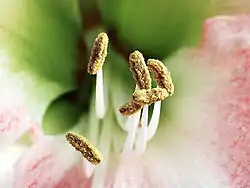花葯
字源
花葯一詞來自拉丁文anthera,意為「從花朵中萃取出的葯」[1][2],而此字有可追溯至古希臘文的ἀνθηρά[2][3],該詞為ἀνθηρός(意為「花朵盛開的」)的雌性變化[4]。依中華民國教育部《重編國語辭典修訂本》及《異體字字典》,正字作「花」,不得作「花」[5]。
描述
花葯可依與花絲的著生方式分為以下數種:
- 基著葯(basifixed):花葯基部連接花絲。大多數被子植物皆屬此類。
- 偽基著葯(pseudobasifixed):指葯隔(connective)在花葯與花絲的連接處形成環繞花絲頂端的管狀構造,出現在延龄草科的植物[6]。
- 背著葯(dorsifixed):花葯中部連接花絲,這種連接法通常花葯與花絲只以一個點相連,所以花葯可以移動,這種情況又稱丁著葯(versatile anther),如水稻與百合)。反之若花葯的背部與花絲完全連接則稱為貼著葯(adnate anther),玉蘭花的雄蕊即是此例[7]。
- 個字著葯(divergent):花葯基部裂成兩半,頂端則著生於花絲[8]。
- 廣岐葯(divaricate):花葯完全裂成兩半,彼此張開成一直線,並以兩片花葯的中間著生於花絲[8]。
- 離室葯(distractible):花葯完全裂成兩半,且兩片花葯距離甚遠,花絲頂端分枝而分別連接兩片花葯[9]。
另外花葯開裂的方式可分為孔裂、瓣裂與縱裂等[8]。
形態與功能
花葯可由葯隔分為兩葉,每一葉稱為一個葯室(locule),從外到內為表皮(epidermis)、纖維層(endothecium)、中間層(middle layer)與絨氈層[10],其中絨氈層對花粉的發育相當重要[11],其細胞通常較大且含有一個以上且較大的細胞核,隨著孢子母細胞的分裂,絨氈層細胞的細胞核也進行分裂,甚至可能因核融合產生多倍體[10]或多絲染色體[12]。特別大的細胞核與提供發育中的花粉養分與各種調節物質有關,除此之外,絨氈層的功能還有協助花粉壁的形成,以及分泌葡聚糖酶(callase)以使減數分裂剛產生的四個小孢子互相分離[13],絨氈層的細胞若遭破壞會使花粉發育失敗[14]。花葯的最內部是1至2個花粉囊,內有小孢子母細胞(microsporocyte),可行減數分裂產生小孢子,再經過有絲分裂產生管細胞與兩個生殖細胞而組成成熟的花粉粒[10]。
參考資料
- Siebenhaar, F.J. (1850). Terminologisches Wörterbuch der medicinischen Wissenschaften. (Zweite Auflage). Leipzig: Arnoldische Buchhandlung.
- Saalfeld, G.A.E.A. (1884). Tensaurus Italograecus. Ausführliches historisch-kritisches Wörterbuch der Griechischen Lehn- und Fremdwörter im Lateinischen. Wien: Druck und Verlag von Carl Gerold's Sohn, Buchhändler der Kaiserl. Akademie der Wissenschaften.
- Klein, E. (1971). A comprehensive etymological dictionary of the English language. Dealing with the origin of words and their sense development thus illustration the history of civilization and culture. Amsterdam: Elsevier Science B.V.
- Liddell, H.G. & Scott, R. (1940). A Greek-English Lexicon. revised and augmented throughout by Sir Henry Stuart Jones. with the assistance of. Roderick McKenzie. Oxford: Clarendon Press.
- http://dict.variants.moe.edu.tw/variants/rbt/word_attribute.rbt?quote_code=QjAzOTcz
- Armen Takhtajan. . Springer. : 632. ISBN 9781402096082.
- Asa Gray. . (原始内容存档于2015-01-22).
- 葉創興、馮虎元. . 清華大學出版社. ISBN 9787040207606.
- . Biology Discussion.
- K. Kubitzki. VII. Springer. : 79. ISBN 9783662072554.
- P.L. Polowick, V.K. Sawhney 1993. Differentiation of the Tapetum During Microsporogenesis in Tomato (Lycopersicon esculentum Mill.), with Special Reference to the Tapetal Cell Wall. Annals of Botany, Volume 72, Issue 6, December 1993, Pages 595–605
- M. Guerra and G. M. G. Carvalheira. . Journal of Heredity. 1994, 85 (1): 43–46.
- Shu-Lan Yang; 等. . Plant Cell. 2003-12, 12 (12). doi:10.1105/tpc.016618.
- Mariani, C.; 等. . Nature. 1990-9, 347: 737–741. doi:10.1038/347737a0.
This article is issued from Wikipedia. The text is licensed under Creative Commons - Attribution - Sharealike. Additional terms may apply for the media files.

